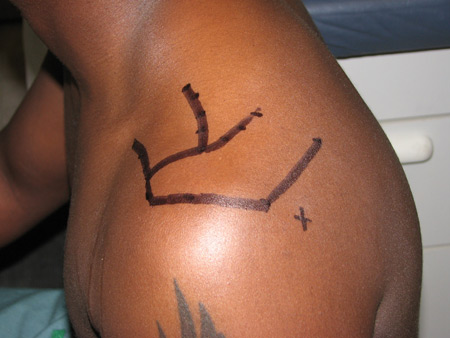Differentials
Rotator cuff impingement
SIGNS / SYMPTOMS
May have weakness due to pain.
INVESTIGATIONS
Advanced imaging will not show rotator cuff tear; may show inflammation within tendons or bursa. MRI would also show some increased fluid in the subacromial space and the subdeltoid bursa, as well as increased signal.
If the rotator cuff is intact, strength should improve after pain-relieving injection of anesthetic.
Rotator cuff tendonitis
SIGNS / SYMPTOMS
May have weakness due to pain.
INVESTIGATIONS
Advanced imaging will not show rotator cuff tear; may show inflammation within tendons.
If the rotator cuff is intact, strength should improve after pain-relieving injection of anesthetic.
Subacromial bursitis
SIGNS / SYMPTOMS
May have weakness due to pain.
INVESTIGATIONS
Advanced imaging will not show rotator cuff tear; may show inflammation within bursa.
If the rotator cuff is intact, strength should improve after pain-relieving injection of anesthetic. [Figure caption and citation for the preceding image starts]: Subacromial injection. Insert needle just inferior to posterior edge of acromion (x), aiming parallel to the undersurface of the acromionFrom the collection of Daniel J. Solomon, MD; used with permission [Citation ends].
Greater tuberosity humerus fracture
SIGNS / SYMPTOMS
Identical presentation to acute tear.
INVESTIGATIONS
Radiographic findings of fracture.
Biceps tendonitis
SIGNS / SYMPTOMS
Tenderness at bicipital groove.
INVESTIGATIONS
Advanced imaging reveals inflammation surrounding biceps tendon and occasionally intrasubstance signal change.
Pain in the anterior region of the shoulder with Speed test (resisted forward arm flexion with the elbow extended) or Yergason test (resisted forward supination).
Glenohumeral osteoarthritis
SIGNS / SYMPTOMS
Can coexist with an acute rotator cuff tear, but the symptoms for each diagnosis differ. Osteoarthritis results in painful glenohumeral stiffness and limitation of active and passive motion. The degree of loss of external rotation in adduction tends to correlate with disease severity. In contrast, loss of passive motion in rotator cuff tear is uncommon. Degenerative changes can occur following untreated chronic massive rotator cuff, but such changes are not seen immediately following an acute tear.
INVESTIGATIONS
X-rays demonstrate typical changes of osteoarthritis (decreased joint space, subchondral sclerosis, subchondral cysts, and osteophyte formation).
Superior labral tear
SIGNS / SYMPTOMS
Weakness is not a presenting symptom. Usually confined to younger patients.
INVESTIGATIONS
MRI finding of a superior labral tear.
Posterior pain during the dynamic labral shear test, as the abducted and externally rotated arm is lowered into adduction.
Pain during the O’Brien test (patient positions his arm at 90° elevation, 10°, and internal rotation (thumb down) with the elbow in extension. The patient then elevates the arm against the downward force applied by the examiner).[30]
Acromioclavicular arthritis
SIGNS / SYMPTOMS
Pain over superior aspect of shoulder, especially at acromioclavicular joint.
Overhead and cross-body activities exacerbate pain.
INVESTIGATIONS
Radiographs demonstrate arthritic changes at the acromioclavicular joint.
MRI shows inflammation at the acromioclavicular joint.
Pain localized to the acromioclavicular joint during cross-body test (the patient's shoulder is forward flexed to 90° and adducted across body).
Use of this content is subject to our disclaimer